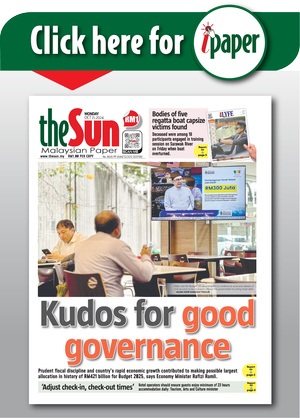KUALA LUMPUR: Media practitioners covering the tragic bus crash involving students from Universiti Pendidikan Sultan Idris (UPSI) on June 9 came under fire from netizens who accused them of attempting to sensationalise the incident.
They believed the journalists should have shown greater sensitivity toward the victims’ families when reporting on the tragedy, which claimed 15 lives.
“I totally agree. Journalists always take advantage while the family is still grieving”; “None of them have ethics or manners”; and “Most journalists these days have no empathy. All they care about is chasing headlines” – these were among the comments posted on social media.
But do media practitioners truly lack empathy, ethics and decency when reporting on tragedies?
SENSATIONAL HEADLINES
Delving into the realities of the media industry, Universiti Malaya Department of Media and Communications Studies senior lecturer Dr Mohd Hafiz Faizal Mohamad Kamil said journalists work under time pressure to meet the demands of audiences who want information as quickly as possible.
However, he added, this is not a “licence” for media practitioners to disregard journalistic ethics upheld by the industry.
He said journalistic ethics are based on the principles of factual accuracy, accountability and fairness, as well as sensitivity to the impact of reports on both the subjects and society.
“In accident reporting, journalists must ensure that all information published has been verified and don’t touch on the sensitivities of victims’ families, and don’t add emotional burden to those involved. This includes avoiding sensational headlines, not publishing images without consent and not forcing families to be interviewed while they are still in trauma,” he told Bernama.
Defining media communication as the process of systematically disseminating facts, information and narratives to the public through various channels such as television, newspapers, digital news portals and social media, the expert said a journalist’s role goes beyond simply reporting events – it also involves building public understanding and social response to issues.
However, in today’s digital age, the way information is delivered also heavily depends on interface designs and how users interact with news platforms.
“As a researcher in this field, I see that the audience’s experience with news content is influenced not only by the content itself but also by how it is presented, including headline selection, visuals and layout, and features such as autoplay videos or push notifications.
“If these elements are not ethically designed, they can affect users’ emotional well-being, especially when reading about tragedies such as the bus crash (involving the UPSI students),” he explained.
MAINSTREAM MEDIA
Meanwhile, according to Mohd Hafiz Faizal, Malaysia’s mainstream media, such as the Malaysian National News Agency (Bernama), Radio Televisyen Malaysia (RTM), TV3 and Astro Awani, still adhere to the journalistic code of ethics established by the Malaysian Media Council and the Malaysian Press Institute.
He said these media outlets verify facts and exercise caution when selecting images.
“However, in today’s highly competitive digital world, we are seeing newer news portals or inexperienced reporters who, along with less rigorous editorial processes, create news reports that are insensitive to public emotions,” he said.
Regarding how well the media respects the sensitivities of victims’ families, he said some media outlets have set a good example by waiting for official statements from institutions, obtaining consent from the families and focusing on constructive narratives such as solidarity and respect for the victims.
“However, not all media do this... some rush to report without careful consideration. This highlights the need for more standardised practices in tragedy reporting within the media industry to ensure the sensitivities of victims’ families are always prioritised,” he added.
TRAUMA-INFORMED REPORTING
Mohd Hafiz Faizal also has this suggestion for journalists tasked with covering a crisis or tragedy – practice trauma-informed journalism.
Explaining that this is one of the best approaches to take, he said it encourages journalists to be empathetic, assess the emotional state of victims or their families before conducting interviews, and avoid asking questions that may cause additional distress.
“From the perspective of digital communication, the way news is presented can influence the user experience. For example, the autoplay videos of tragic events or homepage layouts that prominently display distressing visuals can have a negative impact on users who are not emotionally prepared.
“In this context, a more user-friendly and context-sensitive design approach is needed so that the public can receive information in a more orderly manner without compounding the trauma. Therefore, the role of media practitioners is not just to produce reports but also to consider how those reports are experienced by digital audiences,” he said.
Mohd Hafiz Faizal also said that from his perspective as a lecturer and researcher in the field of media communication, human-computer interaction and digital ethics play a role and hold shared responsibility in ensuring that reports of tragedies are delivered in a respectful and empathetic manner.
“The media must act as responsible conveyors of information who understand the emotional realities of victims, while society must become discerning consumers of information — refraining from sharing sensitive content and respecting the privacy of others.
“In an increasingly open digital ecosystem, ethical regulation is not solely the responsibility of individuals, journalists or media organisations but also system developers, platform providers and users themselves. Therefore, the strengthening of communication ethics must be viewed holistically — encompassing content, system design and public literacy,” he said.
UPHOLD ETHICS
Long accustomed to the various criticisms and accusations thrown at the journalism profession, assistant news/online editor at ‘KOSMO!’ daily Muhammad Firdaus Hassan said media personnel always strive to remain professional in carrying out their duties, guided by journalistic ethics.
“The public needs to understand the scope of a journalist’s responsibilities and the ethical standards practiced in the media. Journalistic ethics refer to the principles and moral guidelines that journalists must follow in performing their duties. These ensure that the news delivered is truthful, fair and responsible.
“In the coverage of the June 9 bus crash, I believe media personnel respected the privacy of the subjects (victims’ families) during interviews and did not simply chase sensational headlines. It is standard practice for the media to seek verified sources, such as family members of victims, before publishing any news,” he said.
In his 16-year career, Muhammad Firdaus, 39, has covered numerous tragedies, including the Lahad Datu intrusion in Sabah, the brutal murder case involving cosmetics entrepreneur Datuk Sosilawati Lawiya, the Giam Bungan boat tragedy in Sarawak, crocodile attacks in Sarawak and several horrific accidents in Perak.
The former crime reporter acknowledged that it is normal for a portion of the audience to be dissatisfied with how the media operates. He said interviewing victims or their families is a standard procedure for crime reporters to obtain footage and news content.
“Before any interview, the victim’s family is usually informed of the questions in advance. In fact, they are free to decline or answer only what they are comfortable with,” he said.
He added that journalists are also bound by principles that prohibit altering, twisting or fabricating facts, in line with the ethics of journalism centred on truth.
“Even journalists are accountable to the public and must serve public interest,” he stressed, adding that the media in Malaysia strongly uphold the principle of respecting privacy and individual rights by not disclosing any personal information without consent.
He also urged the public to try and understand the role of journalists in reporting news as reporters face their own challenges and constraints in delivering information as quickly as possible to the public.
“The public only sees the final product (the reported news) without understanding the reality behind a journalist’s work and the challenges they face. In this digital era, journalists sometimes only have a few hours or even minutes to compile a complex report. Mistakes may occur, not out of malice, but due to time constraints and editorial pressure,” he explained.
DISCRETION
Meanwhile, ‘theSun’ photographer Masry Che Ani, 50, said photographers face immense challenges when covering a tragedy as they not only have to witness horrifying scenes such as mangled bodies and severely injured victims but also deal with authorities who can sometimes hinder their work.
“We adhere to ethics and treat victims and their families with respect. When we approach them courteously, they will be willing to be interviewed or photographed,” said Masry, who has worked in the media industry for 30 years.
“Another thing, if a photo is too sensitive, don’t take it. Sensitivity must be respected. If they don’t give permission, we must comply. Nowadays, the younger generation is sometimes not attuned to the context, especially when it comes to sensitive matters.”
Three years ago, Masry had his moment of fame when he rescued a woman from jumping off the Penang Bridge. His story went viral on social media.
He said he was on his way to an assignment and saw a woman about to jump off the bridge.
“She was about to jump right in front of me... as a media photographer, it would have been a golden opportunity for an exclusive front-page photo. But I chose to save the woman.”
Naturally, his selfless act drew praise from the public. - Bernama









